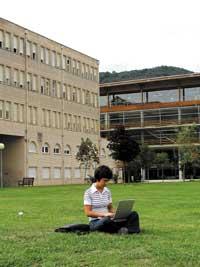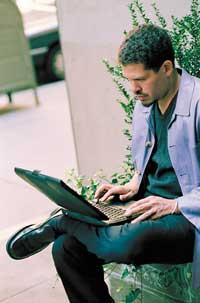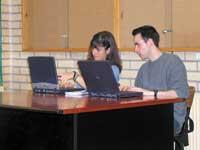WiFi: deployment of wireless connections

The UPV/EHU Computer Service (CIDIR) has pioneered the implementation of wireless areas. In Donostia, in the library of the Faculty of Computer Science, in the cafeteria and even in the countryside, students and teachers can connect to the network without cables. (Photo: O. Araolaza).
The Internet network has completely covered all corners of the University of Twente. The Dutch university is an example of the changes that will involve wireless or wireless zones. Students and teachers can connect to the computer network from anywhere on the 140 hectares of the university campus in the course just started. To do this, they have enabled 650 hotspots or access points distributed by the campus. Twente's 6,000 students can access the Internet from the library, pool or field, installing a WiFi card in their laptop and without cables or cables. Students and teachers will have at their disposal the largest wireless network in Europe.
Big IT companies have considered the Twente campus as a tester, so they have prepared a unique wireless zone for the moment. But beyond the evidence, the expansion of WiFi networks is a bone reality and after the crisis of Puncom has brought new winds, or at least has resurrected business illusions to the industry. In airports, large companies and hotels, universities and congress centres the first areas have been established. In Euskal Herria the first sessions were also held through the university. The Donostia campus of the University of the Basque Country was one of the pioneers and the wireless network launched at the Faculty of Computer Science has been running for a year and a half.
On the streets WiFi
But together with the large universities and companies, the groups of citizens organized in associations have also assumed the initiative of getting the Internet anywhere and are preparing the access points autonomously. Groups such as Euskal Wirelesss, Donosti-Wireless, Bilbowireless or Anuestroaire de Vitoria are working on it. They place access points in the streets of the cities and allow to surf the Internet without plugging into any place in the space of about 100 meters that occupy the waves.

In the cities there are initiatives underway, but also in small towns. For example, in the Navarra town of Aiegi, the WiFi network has been installed among its neighbors. In small and, therefore, economically unprofitable populations, they do not have much hope that the cable will reach them. Therefore, without waiting for communication companies to arrive, anticipate and citizenship has begun to work on the deployment of WiFi networks.
In fact, WiFi has become a good solution to offer Internet access in neighborhoods, towns and regions that were being left aside from major communication networks. South of the Pacific, on the small island called Niue, 1,700 people live. The island has 260 km 2 and from there only the sea. Being completely isolated as far as Earth is concerned, we understand the passion of its inhabitants for accessing the Internet. They have created an association of Internet fans and have established access points that offer connection to cover the entire island.
Avoiding the digital divide
Organizations have seen wireless as an interesting resource to reduce the digital divide and have fully addressed the outreach efforts of wireless technology. The digital divide is defined as the interval that occurs between those who have and do not have access to new communication technologies. For example, according to the latest data provided by Eustat, 31% of Basque households have Internet access. This connection rate is low compared to countries like Denmark, the Netherlands or Sweden, leaders in this field, where about 65% of the population has Internet access in their home.
If we look at the data through the mirror, concern can increase. In fact, by saying that in 31% of CAPV homes there is internet connection, we are indicating that 69% of the population does not have access from home. Some of them will surely have another way to access the Internet, at work, at school, at the internet cafes or at the Kzgunea, but others do not have it, and that is the digital divide that concerns many experts.

In fact, several organizations have begun to see WiFi technology that can take the Internet to any street and its environment, one of the ways to reduce the digital divide. Spri has granted support for the installation of wireless networks with WiFi technology in public places and the Basque Government has rated the wireless area as a strategic research line. Several entities have begun to offer the possibility of connecting to the Internet in the streets of cities creating wireless spaces. In Zamora, for example, the company Wireless Satellite Networsk has already covered 75% of the urban area.
Communication on radio
A wireless network or wireless network is basically a network that connects computers to each other without using cables. Wireless networks are common in our daily lives. For example, it should not be said that communication between the television and the hand control is done wirelessly. The television and the handheld control are connected by infrared rays. Infrared is also used between PDA laptops or GSM phones.
Infrared rays allow sending and receiving information at a maximum speed of 4 Mbps. But for communication between infrared rays to take place, it is necessary for both the transmitter and the receiver to review each other and there are no obstacles to each other. For that reason, with the handheld command, it is necessary to make pointers sometimes in order to be able to change television channel.

The radiofrequency is increasingly present in the appliances. In addition to the already extended radio and TV signals, now, in some cars, the keys that open remotely work by radiofrequency, the garage doors, the wireless phones of the house and, of course, the mobile phones type GSM.
Several standards for wireless networks have been launched in recent years, including 802.11, regulated by the IEEE (Institute of Electrical and Electronic Engineers). One of its versions, the 802.11b, is the one that has extended most and around it has been created the commercial name WiFi, abbreviation for Wireless Fidelity. The 802.11b standard works at 2.4 GHz of frequency width and has a maximum transmission speed of 11 Mbps. Once the access point is installed, you can connect about 10 computers via this hotspot or access and depending on the walls and obstacles of the environment, it will be available in a radius of about 100 meters.
The 802.11b standard is the one that has achieved the most diffusion and around which the name of WiFi has been extended, but the new business space has attracted investments and is continuously marketing new tools that improve the capacities of the previous one. For example, 802.11g offers a bandwidth of 56 Mbps. The AG100 chip presented in Silicon Valley in August 2003 announces a new leap in wireless networks. This new technology, called MIMO, has announced a maximum transmission speed of 108 Mbps. In addition, the area that can cover can be up to six times greater.






